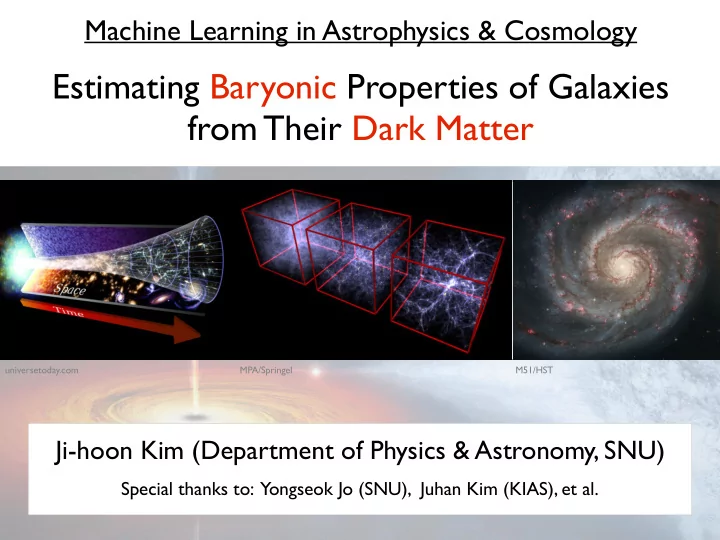

Machine Learning in Astrophysics & Cosmology Estimating Baryonic Properties of Galaxies from Their Dark Matter universetoday.com MPA/Springel M51/HST Ji-hoon Kim (Department of Physics & Astronomy, SNU) Special thanks to: Yongseok Jo (SNU), Juhan Kim (KIAS), et al.
Evolution of Our Universe ● Based on the mankind’s best guess for our Universe, standard Big Bang LCDM cosmology.
Numerical Cosmology: Structure Formation Evolution for the past ~13.6 billion years Dark matter - interacts only by 150 million gravitational force light-years - dominates structural evolution Kravtsov et al. www.jihoonkim.org
Kim et al. NASA/GSFC Governato et al. Governato et al.
Large-Scale Structure (LSS) of Universe Dark matter web (Abel et al.) Lemson et al. ~2 billion “Galaxies” light-years
Numerical Experiment in Cosmology ● Numerical experiment essential due to galaxy’s nonlinear nature → often the only tool to test a theory on Universe’s evolution Jonsson/GADGET-2 Teyssier/RAMSES Moody/ART-I Teyssier/RAMSES Kim/ENZO Wadsley/GASOLINE Guedes/GASOLINE Guedes/GASOLINE Agertz/RAMSES Kim/GIZMO Pontzen/CHANGA Keller/GASOLINE Renaud/RAMSES Guedes/GASOLINE Agertz/RAMSES Hopkins/GIZMO Vogelsberger/AREPO Fujimoto/ENZO Gallery of galaxy-scale cosmological simulations www.jihoonkim.org
Numerical Galaxy Formation: Upcoming Era Mass resolution in stellar disk (M ⊙ ) 10 9 10 7 Hopkins+ 2015 Barnes 1988 Springel+ 2005 10 5 10 3 Holmberg 1941 Toomre 1978 Next 10 1 Decade 2010 1940 1980 1990 2000 2020 2030 Year 2019 www.jihoonkim.org
Galaxies: Building Blocks of Universe ● Galaxies sit right in the middle of cosmological distance scale. → Universe’s building blocks + give contexts for star formation ~10 9 pc ~10 6 pc ~10 4 pc ~10 1 pc ~10 0 pc ~10 -4 pc Planets Stars Star Clusters Galaxies Galaxy Large-scale Clusters Structures * 1 parsec (pc) = 3.26 light-year www.jihoonkim.org
Multi-scale, Nonlinear Interactions R halo Gas Gas Star MBH Stars or Molecular Clouds Massive Black Hole (MBH) (Inter-)Galactic Formation & Feedback Accretion & Feedback Dynamics & Interaction R Bondi ~ pc R GMC ~ 10 pc R halo ~ 100 kpc R Schw. ~ 10 -5 pc SFR in M33 M87/VLA Radio M51/HST www.jihoonkim.org
Self-consistent Simulation Framework ● Self-consistent galaxy-SMBH co-evolution from first principles - computing techniques like adaptive refinement help include more physics Massive Black Hole Star-forming Clumps Multi-scale Hydrodynamics Accretion & Feedback Formation & Feedback Simulation Code —— Adaptive Mesh Refinement Artificially boosted Insert a star simply by Enzo (Bryan et al. 2014) Schmidt law ( ρ SFR ~ ρ gas1.5 ) Bondi accretion Previous Work Thermal Turn off gas cooling or energy thermal energy Bondi accretion Insert a star when a cell of without any boost factor ~10 3 M ⊙ turns Jeans unstable Adaptive mesh New UV/X-ray photons + Winds Approach UV photons radiative transfer (photoheating & ionization) + Supernova thermal energy www.jihoonkim.org
Adaptive Mesh Refinement Cosmology ● Adaptively focus on regions of high interests - refines cells if found interesting; e.g., dense, collapsing, unstable, shocked ● More easily include relevant physics for galaxy-SMBH evolution - e.g., gravity, hydrodynamics, radiation, cooling, chemistry, stellar physics Enzo AMR level=0 level=1 level=2 Abel et al. (2002) www.jihoonkim.org
Numerical Galaxy Formation: Upcoming Era Mass resolution in stellar disk (M ⊙ ) 10 9 10 7 Hopkins+ 2015 Barnes 1988 Springel+ 2005 10 5 10 3 Holmberg 1941 Toomre 1978 Next 10 1 Decade 2010 1940 1980 1990 2000 2020 2030 Year 2019 www.jihoonkim.org
Gravity and Hydrodynamics ● Gravity (dominated by dark matter) drives Universe’s evolution. ● Hydrodynamics and others small-scale physics (dominated by baryon or ordinary matter) affect detailed properties of galaxies. MPA/Springel ESA/Planck (2013) www.jihoonkim.org
Gravity and Hydrodynamics ● There is a hint that we may reliably correlate baryonic (normal matter) properties of a galaxy only with dark matter properties. Large-scale structure sculpted by dark matter Galaxies Baryonic interactions inside a galaxy www.jihoonkim.org
Machine-assisted Semi-Simulation Model (MSSM) www.jihoonkim.org
Machine-assisted (Semi-)Simulation ● Predict ordinary matter from dark matter using ERT TRAINING DARK MACHINE Yongseok Jo, MATTER Hydrodynamic kerex@snu.ac.kr LEARNING DATA arXiv:1908.09844 Simulation MODEL (MNRAS, 2019) Halo Catalog BARYON DATA APPLICATION MACHINE Dark Matter Only DARK LEARNING BARYON Simulation MATTER MODEL DATA Halo Catalog DATA
Machine-assisted (Semi-)Simulation ● Done in negligible time (~hours) compared to full-scale hydrodynamic simulation (~months). ● Can “paint” a large DM-only simulation with the result from a smaller, high-resolution simulation. Yongseok Jo, kerex@snu.ac.kr arXiv:1908.09844 (MNRAS, 2019) Dark matter of IllustrisTNG colored This work IllustrisTNG with baryons Left: DM density of IllutrisTNG with circles representing virial radii. Middle/right: circles representing stellar masses colored by baryon fraction
̂ Improvements In Machine Design Previous work This work Considers 3 input properties of Considers 11 inputs including the halo’s only the target halo itself growth history and its local environment By building a two-stage tree, model grows Model grows exponentially linearly, resulting in smaller but deeper ERT n N Error = 1 Error = 1 ∑ ∑ (log y i log y i hydro ) 2 (y i y i hydro ) 2 pred − pred − ̂ n N i i Default error function in ERT Refined error function
Improved Machine Performance ● More accurate prediction compared to previous attempts. MSE: ~0.02 MSE: ~0.0002 based only on dark matter Predicted stellar mass Stellar mass in each galaxy from a full simulation www.jihoonkim.org
Machine Better Than Human Parametrization ● Machine (red line) predicts galaxy’s baryonic properties better than a human-devised parametrization model (blue line) does. Galactic stellar mass distribution Massive black hole distribution in the Universe in the Universe www.jihoonkim.org
Machine-assisted (Semi-)Simulation ● Viable to generate a large, yet detailed mock Universe with ML. - a large volume to enclose variations at a “cosmological” scale - and yet a detailed physics and structures at a very small scale NASA illustris-project.org sdss.kias.re.kr/astro/Horizon-Runs/ www.jihoonkim.org
Machine Learning in Astrophysics & Cosmology Estimating Baryonic Properties of Galaxies from Their Dark Matter 1. New Opportunity: ● Ever-increasing Importance of Numerical Cosmology ● Advances in Machine Learning arXiv:1908.09844 II. Newly Possible Research: (MNRAS, 2019) ● Possibility of “Machine-assisted” (Semi-)Simulation www.jihoonkim.org
Recommend
More recommend